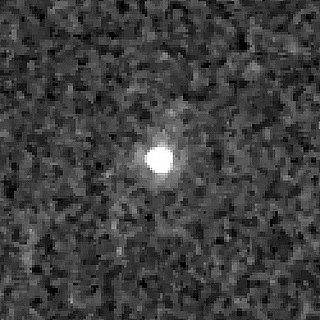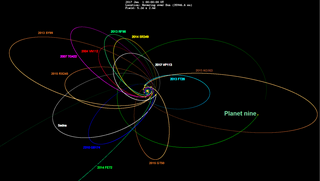Related Research Articles

(42301) 2001 UR163, prov. designation: 2001 UR163, is a resonant trans-Neptunian object and possible dwarf planet located in the outermost region of the Solar System. The object measures approximately 352 kilometers (220 miles) in diameter with a high albedo and stays in an uncommon orbital resonance (4:9) with Neptune. It was discovered on 21 October 2001 by astronomers of the Deep Ecliptic Survey program at Kitt Peak National Observatory near Tucson, Arizona, United States. As of 2021, it has not been named.
(445473) 2010 VZ98, provisional designation 2010 VZ98, is a trans-Neptunian object of the scattered disc, orbiting the Sun in the outermost region of the Solar System. It has a diameter of approximately 400 kilometers.

2010 GB174 is a detached object, discovered on 12 April 2010 on data taken at the Canada France Hawaii Telescope as part of the Next Generation Virgo Cluster Survey. It never gets closer than 48.5 AU from the Sun (about the outer edge of the Kuiper belt). Its large eccentricity strongly suggests that it was gravitationally scattered onto its current orbit. It is, like all detached objects, outside the current influence of Neptune, so how it got its current orbit is unknown. 2010 GB174 has the third highest Tisserand parameter relative to Jupiter of any Trans-Neptunian object, after Sedna and 2012 VP113. It has not been observed since 2015. It comes to opposition in late March each year in the constellation of Virgo.
(523645) 2010 VK201, provisional designation 2010 VK201, is a trans-Neptunian object and member of the classical Kuiper belt, approximately 500 kilometers (310 miles) in diameter. It was discovered on 1 November 2010, by the Pan-STARRS 1 survey at Haleakala Observatory, Hawaii, United States. It has a rotation period of 7.6 hours. It was numbered in September 2018 and remains unnamed.

2013 SY99, also known by its OSSOS survey designation uo3L91, is a trans-Neptunian object discovered on September 29, 2013 by the Outer Solar System Origins Survey using the Canada–France–Hawaii Telescope at Mauna Kea Observatory. This object orbits the Sun between 50 and 1,300 AU (7.5 and 190 billion km), and has a barycentric orbital period of nearly 20,000 years. It has the fourth largest semi-major axis for an orbit with perihelion beyond 38 AU. 2013 SY99 has one of highest perihelia of any known extreme trans-Neptunian object, behind sednoids including Sedna (76 AU), 2012 VP113 (80 AU), and Leleākūhonua (65 AU).

(523794) 2015 RR245, provisional designation 2015 RR245, is a large trans-Neptunian object of the Kuiper belt in the outermost regions of the Solar System. It was discovered on 9 September 2015, by the Outer Solar System Origins Survey at Mauna Kea Observatories on the Big island of Hawaii, in the United States. The object is in a rare 2:9 resonance with Neptune and measures approximately 600 kilometers in diameter. 2015 RR245 was suspected to have a satellite according to a study announced by Noyelles et al. in a European Planetary Science Congress meeting in 2019.

2014 UZ224 is a trans-Neptunian object and possible dwarf planet orbiting in the scattered disc of the outermost Solar System. As of 2021, it is approximately 89.7 AU (13.42 billion km) from the Sun, and will slowly decrease in distance until it reaches its perihelion of 38 AU in 2142. The discoverers have nicknamed it "DeeDee" for "Distant Dwarf".

2015 RX245 is an extreme trans-Neptunian object, detached, on a highly eccentric orbit in the outermost region of the Solar System. It measures approximately 250 kilometers (160 miles) in diameter and is "possibly" a dwarf planet. It was first observed on 8 September 2015, by astronomers with Outer Solar System Origins Survey using the 3.6-meter Canada–France–Hawaii Telescope at Mauna Kea Observatories, Hawaii, in the United States.

2015 GT50, previously known as o5p060, is a trans-Neptunian object orbiting in the Kuiper belt of the outermost Solar System. It was first observed by the Outer Solar System Origins Survey using the Canada–France–Hawaii Telescope at Mauna Kea on 13 April 2015.

2015 KG163, also known as o5m52, is a trans-Neptunian object from the outermost region of the Solar System, approximately 102 kilometers (63 miles) in diameter. It was first observed on 24 May 2015, by astronomers of the Outer Solar System Origins Survey using the Canada–France–Hawaii Telescope at Mauna Kea Observatories, Hawaii, United States. With an observation arc of 2 years, it passed perihelion around August 2022 at a velocity of 6.5 km/s with respect to the Sun.
(505478) 2013 UT15 is an extreme trans-Neptunian object from the scattered disc, located in the outermost regions of the Solar System, approximately 260 kilometers (160 miles) in diameter. It was discovered on 2 August 2013, by astronomers of the Outer Solar System Origins Survey at Mauna Kea Observatory, Hawaii, United States.
2015 RY245, also known as o5s13, is a trans-Neptunian object from the scattered disc of the outermost reaches of the Solar System, approximately 78 kilometers in diameter. It was discovered on 9 September 2015, by the Outer Solar System Origins Survey using the Canada–France–Hawaii Telescope at Mauna Kea Observatories, Hawaii, United States.
2015 KH163, is a trans-Neptunian- and scattered disc object from the outermost region of the Solar System, approximately 117 kilometers in diameter. It was first observed by astronomers during the Outer Solar System Origins Survey at the Mauna Kea Observatories on 24 May 2015.
(506479) 2003 HB57, is an extreme trans-Neptunian object of the extended scattered disc in the outermost region of the Solar System, approximately 180 kilometers in diameter. It was discovered by astronomers at the Mauna Kea Observatory on 26 April 2003.
(315530) 2008 AP129 is a trans-Neptunian object and possibly a cubewano from the outermost regions of the Solar System, approximately 480 kilometers in diameter. It was discovered on 11 January 2008, by American Michael E. Brown and Megan Schwamb at Palomar Observatory in California.

2015 BP519, nicknamed Caju, is an extreme trans-Neptunian object from the scattered disc on a highly eccentric and inclined orbit in the outermost region of the Solar System. It was first observed on 17 January 2015, by astronomers with the Dark Energy Survey at Cerro Tololo Observatory (W84) in Chile. It has been described as an extended scattered disc object (ESDO), and fits into the group of extreme objects that led to the prediction of Planet Nine, and has the highest orbital inclination of any of these objects.
2015 FJ345 is a trans-Neptunian object and detached object, located in the scattered disc, the outermost region of the Solar System. It was first observed on 17 March 2015, by a team led by American astronomer Scott Sheppard at the Mauna Kea Observatories, in Hawaii, United States. With its perihelion of almost 51 AU, it belongs to a small and poorly understood group of very distant objects with moderate eccentricities. The object is not a dwarf planet candidate as it only measures approximately 120 kilometers (75 miles) in diameter.
(523635) 2010 DN93, provisional designation 2010 DN93, is a trans-Neptunian object from in the scattered disc located in the outermost region of the Solar System. It was discovered on 26 February 2010, by astronomers with the Pan-STARRS survey at Haleakala Observatory on the island of Maui, Hawaii, in the United States. Assuming a low albedo, the object is estimated at approximately 490 kilometers (300 miles) in diameter. It was numbered in 2018 and remains unnamed.
(505448) 2013 SA100, provisional designation 2013 SA100 and also known as o3l79, is a trans-Neptunian object from the classical Kuiper belt in the outermost region of the Solar System. It was discovered on 5 August 2013, by astronomer with the Outer Solar System Origins Survey at the Mauna Kea Observatories, Hawaii, in the United States. The classical Kuiper belt object belongs to the hot population and is a weak dwarf planet candidate, approximately 260 kilometers (160 miles) in diameter.
2021 RR205 is an extreme trans-Neptunian object and sednoid discovered by astronomers Scott Sheppard, David Tholen, and Chad Trujillo with the Subaru Telescope at Mauna Kea Observatory on 5 September 2021. It resides beyond the outer extent of the Kuiper belt on a distant and highly eccentric orbit detached from Neptune's gravitational influence, with a large perihelion distance of 55.5 astronomical units (AU). Its large orbital semi-major axis (~1,000 AU) suggests it is potentially from the inner Oort cloud. Like 2013 SY99, 2021 RR205 lies in the 50–75 AU perihelion gap that separates the detached objects from the more distant sednoids; dynamical studies indicate that such objects in the inner edge this gap weakly experience "diffusion", or inward orbital migration due to minuscule perturbations by Neptune.
References
- 1 2 3 4 5 "JPL Small-Body Database Browser: 496315 (2013 GP136)" (2017-05-24 last obs.). Jet Propulsion Laboratory . Retrieved 30 July 2017.
- 1 2 "496315 (2013 GP136)". Minor Planet Center. Retrieved 30 July 2017.
- ↑ Shankman, Cory; et al. (2017). "OSSOS. VI. Striking Biases in the Detection of Large Semimajor Axis Trans-Neptunian Objects". The Astronomical Journal . 154 (2): 50. arXiv: 1706.05348 . Bibcode:2017AJ....154...50S. doi: 10.3847/1538-3881/aa7aed . hdl:10150/625487. S2CID 3535702.
- 1 2 "List of Known Trans-Neptunian Objects". Johnston's Archive. 22 July 2017. Retrieved 30 July 2017.
- 1 2 Malhotra, Renu; Volk, Kathryn; Wang, Xianyu (2016). "Corralling a distant planet with extreme resonant Kuiper belt objects". The Astrophysical Journal Letters . 824 (2): L22. arXiv: 1603.02196 . Bibcode:2016ApJ...824L..22M. doi: 10.3847/2041-8205/824/2/L22 . S2CID 118422279.
- "MPEC 2015-R47 : 2013 GP136". IAU Minor Planet Center. 19 March 2016. Retrieved 19 March 2016.